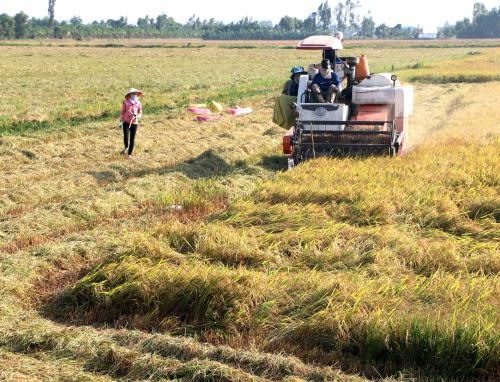 Society
Society

The Southern region plans to reduce the cultivation area of the winter-spring rice crop 2016-17 as drought and saline intrusion are expected to affect the area.
 |
| The Southern region is expected to plant 1.6 million hectares of rice in the 2016-17 winter-spring crop, down about 5,000ha compared to the 2015-16 winter-spring rice crop. — VNA/VNS Photo Huỳnh Sử |
HCM CITY — The Southern region plans to reduce the cultivation area of the winter-spring rice crop 2016-17 as drought and saline intrusion are expected to affect the area.
About 1.6 million hectares of rice are to be planted in the 2016-17 winter-spring crop, down about 5,000ha compared to the 2015-16 winter-spring crop, according to the Ministry of Agriculture and Rural Development’s Plant Cultivation Department.
Of the figure, the Cửu Long (Mekong) Delta, the country’s rice granary, will plant more than 1.5 million hectares and the Southeastern provinces nearly 75,000ha.
Speaking at a seminar held in Hậu Giang Province on Oct 5, Nguyễn Văn Hoà, deputy head of the Plant Cultivation Department, said the region would face a shortage of fresh water for the 2016-17 winter-spring crop.
More than 300,000 ha of the winter-spring rice in southern coastal provinces will likely be affected by drought and saline intrusion, he said.
This year the annual flooding has been less than normal in the Mekong Delta because the Mekong River and its tributaries have been lower than normal.
Đặng Văn Dũng, deputy director of the South Centre for Hydrometeorology Forecasting, said salt water intrusion at river mouths in the south would occur earlier than in previous years.
The region was asked to adjust sowing schedules for winter-spring rice to mitigate the impact of salinity intrusion and drought. Hoà said the Plant Cultivation Department had set up sowing schedules for the region.
Under the schedule, the region will sow about 420,000 ha of winter-spring rice this month, continue sowing the remaining areas in following months, and finish the sowing by January 10, 2017.
Lê Quốc Doanh, deputy minister of Agriculture and Rural Development, said the ministry asked relevant agencies to monitor and promptly provide information about saline intrusion to the delta’s departments and sectors.
Tăng Đức Thắng, deputy director of the Southern Irrigation Science Institute, said the institute would measure the salinity of water at 39 saline-measuring stations in the delta earlier than usual this year.
The measuring results will be sent to the delta’s provinces and media so the delta farmers can start planting rice early.
Participants at the seminar said the delta should use more rice varieties resistant to drought and salinity. In addition, the provinces should dredge canals, consolidate embankments, and store fresh water, they said. — VNS




